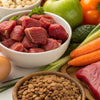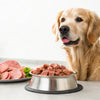How Much Raw Food to Feed a 100 lb Dog: A Comprehensive Guide
- Houndsy
Table of Contents
- Introduction
- Understanding Raw Feeding Basics
- Calculating Raw Food Portions for a 100 lb Dog
- Types of Raw Food to Consider
- Transitioning to Raw Food
- The Role of Quality and Consistency
- Enhancing the Feeding Experience with Houndsy Kibble Dispenser
- Conclusion
Introduction
As our canine companions grow, so do their nutritional needs. Did you know that a 100 lb dog requires anywhere from 4 to 6 pounds of raw food each day? Understanding how to provide the right amount of raw food not only helps maintain optimal health but also promotes a vibrant lifestyle for our furry friends. At Houndsy, we believe that every aspect of pet care should be convenient, consistent, and appealing, including meal times.
In our exploration today, we will delve into the specific needs of a 100 lb dog when feeding raw food. You will learn about the ideal percentage of body weight for feeding, factors that influence dietary requirements, and practical tips for establishing a successful raw feeding routine. Additionally, we will introduce our flagship product, the Houndsy Kibble Dispenser, designed to enhance the feeding experience as well as ensure portion control and convenience.
By the end of this post, you will have a comprehensive understanding of how much raw food to feed your large dog, along with insights for maintaining their overall well-being. So, let’s get started on this culinary journey that takes us deeper into the world of raw dog diets!
Understanding Raw Feeding Basics
Raw feeding is gaining popularity as a healthier alternative to processed commercial dog foods. It revolves around providing your dog with whole, unprocessed foods that resemble a natural canine diet. But why raw? Here are a few reasons:
- Nutritional Integrity: Raw diets often contain fresh meats, organs, and bone, which are packed with essential nutrients.
- Digestive Health: Dogs tend to thrive on a diet that doesn’t include fillers or additives, leading to better digestion.
- Energy Levels: Many owners report heightened energy levels and improved coat health when their dogs are switched to a raw diet.
When it comes to calculating how much raw food to feed a 100 lb dog, the general guideline is to provide between 2% and 3% of their ideal body weight daily. For a 100 lb dog, this translates to 2-3 pounds of raw food each day.
Key Factors Impacting Feeding Amounts
Before you dive into feeding raw, it's crucial to assess specific factors that impact your dog’s dietary requirements:
- Activity Level: A highly active dog may require more calories, while a less active one might need fewer.
- Metabolic Rate: Different breeds and individual dogs can have varying metabolic rates. For instance, a Greyhound has a different metabolism compared to a Bulldog.
- Age: Puppies will require more food relative to their size due to their growth needs, while senior dogs often need less.
- Health Status: Consult with your veterinarian to adjust feeding if your dog has health concerns or special dietary needs.
By taking these considerations into account, you'll be well on your way to developing a feeding plan tailored to your dog.
Calculating Raw Food Portions for a 100 lb Dog
Now that we understand the basics, let’s look at how much raw food to feed a 100 lb dog with practical calculations.
Formula for Feeding Amounts
The recommended daily feeding amounts for a raw diet fall within these percentages:
- For Weight Maintenance: 2-3% of body weight.
Using these percentages to calculate the daily food requirement for a 100 lb dog:
- 2% of 100 lbs: 2 lbs of raw food per day.
- 2.5% of 100 lbs: 2.5 lbs of raw food per day.
- 3% of 100 lbs: 3 lbs of raw food per day.
Thus, a 100 lb dog should generally be fed between 2 and 3 pounds of raw food daily. As a responsible pet owner, monitor your dog’s weight regularly and adjust the food intake as necessary.
Breaking Down the Daily Portion
For optimal feeding practices, we recommend splitting the total daily portion into two meals. For instance, if you're feeding 3 pounds of raw food daily:
- Morning Meal: 1.5 pounds
- Evening Meal: 1.5 pounds
This not only helps with digestion but can also mitigate the chances of bloating, common in larger breeds.
Types of Raw Food to Consider
With the right amounts established, let’s explore the different components of raw feeding. A balanced raw diet can include:
- Meats: Muscle meat is essential. This includes muscle cuts like chicken thighs, beef, and organ meats such as liver and kidneys.
- Bones: Raw meaty bones provide calcium and phosphorous. Be cautious with weight-bearing bones that can splinter easily.
- Vegetables and Fruits: Adding dog-safe fruits and veggies (like carrots, blueberries, and pumpkin) provides fiber and essential nutrients.
Balancing these elements ensures a comprehensive and promising diet for your dog.
A Sample Diet Plan for a 100 lb Dog
To illustrate how to balance these ingredients, here’s a sample daily raw meal plan for a 100 lb dog:
-
Breakfast:
- 1 lb of ground turkey (muscle meat)
- 0.5 lb of chicken necks (bone)
- 0.5 lb of carrot (vegetable)
-
Dinner:
- 1 lb of beef liver (organ meat)
- 0.5 lb of beef tripe (digestive health)
- 0.5 lb of sweet potato (carbohydrate)
Implementing variety is key, as it ensures that your dog receives a range of nutrients essential for health.
Transitioning to Raw Food
When making the switch to raw food, take care to transition slowly to prevent gastrointestinal upset. Here’s a gradual approach:
- Week 1: Start with 10% raw mixed with 90% current diet.
- Week 2: Adjust to 25% raw and 75% current diet.
- Week 3: Move to 50% raw.
- Week 4: Finally transition to a full raw diet.
Throughout this process, observe your dog for any signs of discomfort or changes in digestion.
The Role of Quality and Consistency
At Houndsy, we emphasize the importance of quality, integrity, and consistency in everything we do, especially in feeding practices. When switching to a raw diet, choose high-quality ingredients, ideally sourced from reputable suppliers. This choice directly impacts your dog's health, vitality, and longevity.
Enhancing the Feeding Experience with Houndsy Kibble Dispenser
Feeding time is a ritual that can set the tone for the day, and our flagship product, the Houndsy Kibble Dispenser, is designed to elevate this experience.
Seamless Design and Functionality
- Convenient Access: The crank at standing height eliminates the need for bending, making feeding effortless.
- Perfect Portion Control: Our dispenser allows precise measurement, ensuring your dog gets the right amount, every time—whether you're feeding raw or dry kibble.
- Dimensions that Fit: Capable of holding 25-30 lbs of food, it's perfect for large breed owners who require greater storage without sacrificing aesthetics.
- Safety First: With a BPA-free liner and auto-locking mechanism, it keeps food fresh and prevents spillage by curious pets or toddlers.
Utilizing the Houndsy Kibble Dispenser not only streamlines your feeding routine but also enhances the overall experience for both you and your canine friend, combining design excellence with quality and reliability.
Conclusion
Feeding a 100 lb dog requires careful consideration of the right quantities and quality of raw food. By following the calculated guidelines and ensuring a balanced diet, you can foster your pet's health and vitality. Transitioning smoothly, offering a variety of ingredients, and maintaining a consistent feeding schedule will yield the best results.
We encourage you to embrace the benefits of raw feeding while exploring the innovative advancements in pet care with Houndsy. Our commitment to enhancing the feeding experience ties in perfectly with your journey toward providing the best for your furry family member.
Are you ready to redefine mealtime for your dog? Check out the Houndsy Kibble Dispenser today, and elevate the feeding ritual to new heights.
FAQ
How much raw food should I feed my 100 lb dog?
For a 100 lb dog, it's generally recommended to feed between 2-3 pounds of raw food per day, depending on activity level, age, and health.
Can I mix raw food with kibble?
Yes, but when transitioning to raw food, it's best to do it gradually and avoid feeding raw and kibble in the same meal to prevent digestive issues.
What should I include in my dog's raw diet?
Your dog's raw diet should include a variety of meats, organs, bones, and safe vegetables/fruits to provide a balanced nutritional profile.
How do I know if my dog is getting enough food?
Monitor your dog’s weight, energy levels, and overall health. Adjust portion sizes as needed to maintain an ideal weight.
Is raw food diet safe for all dogs?
While many dogs thrive on raw diets, some may have health issues that require a different approach. Always consult with a veterinarian before changing your dog’s diet.
Feeding your dog a raw diet can be a remarkable journey that promotes health and vitality. With proper knowledge and the right tools, we can make it a fulfilling experience for both pets and their owners.













